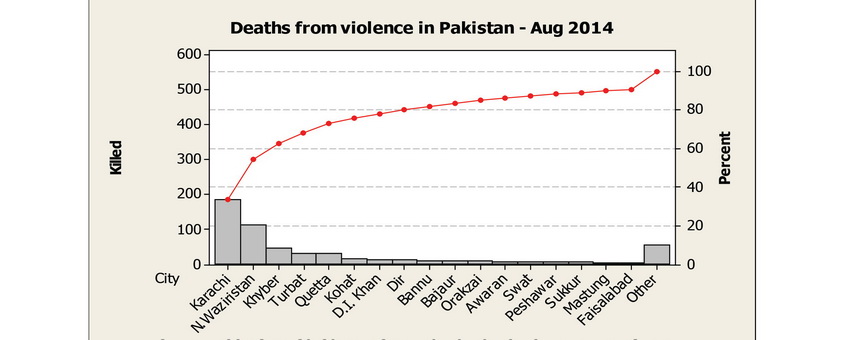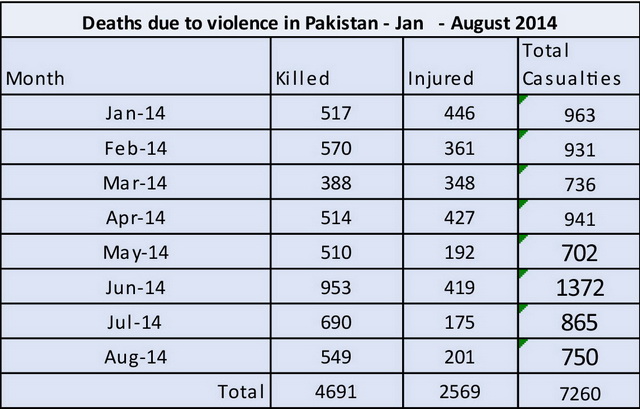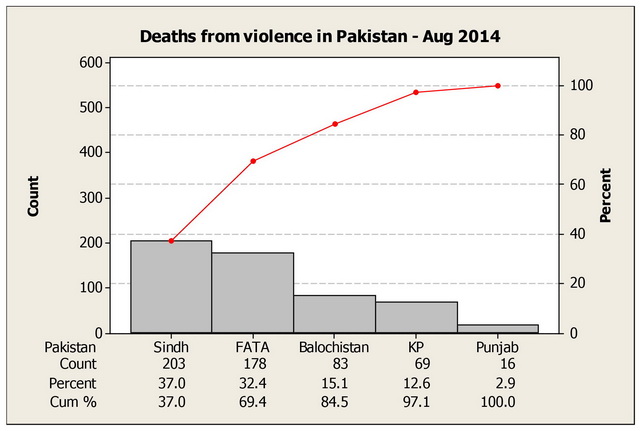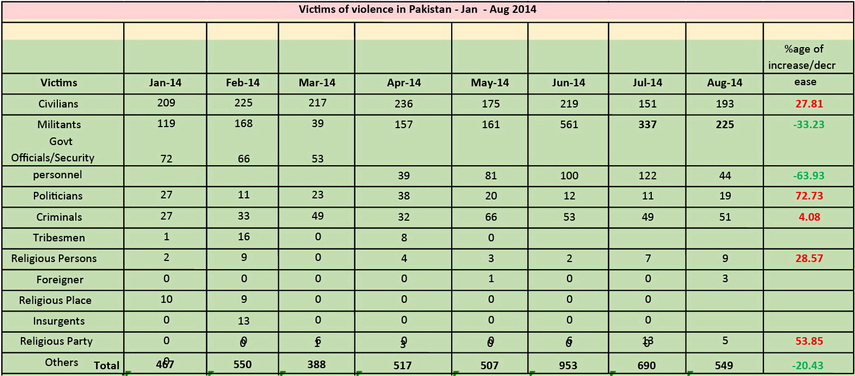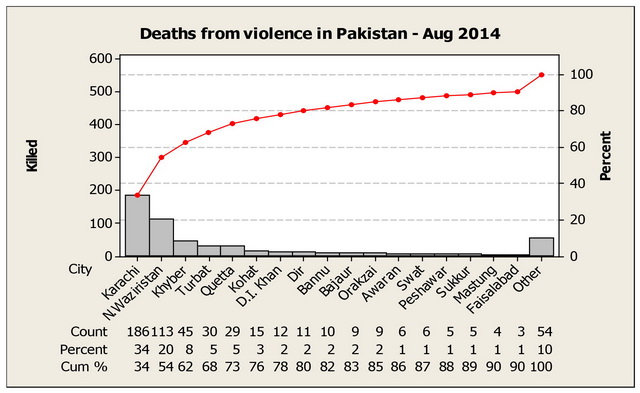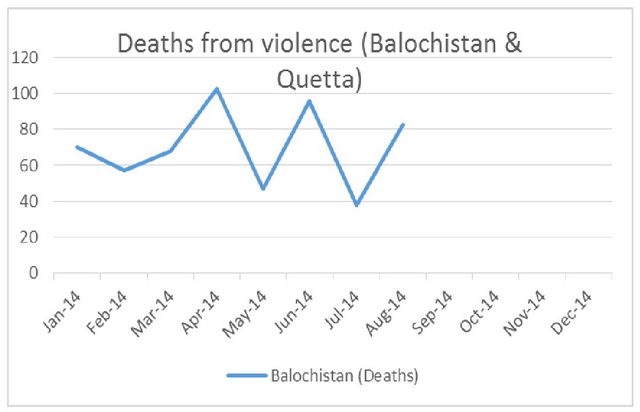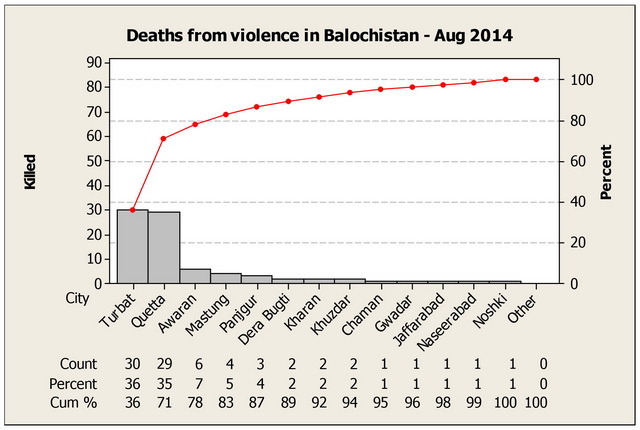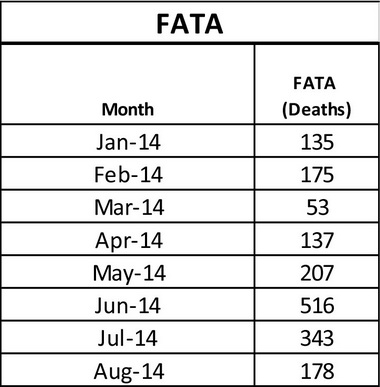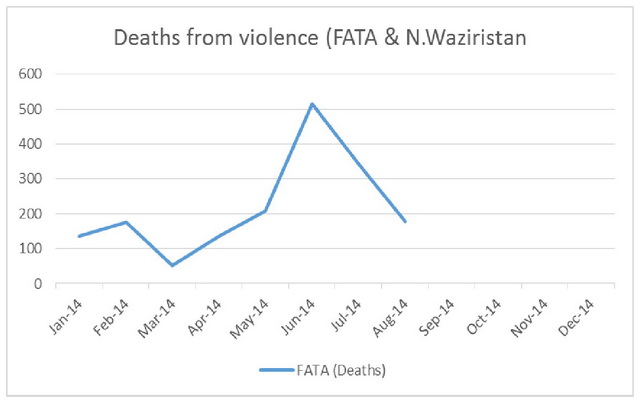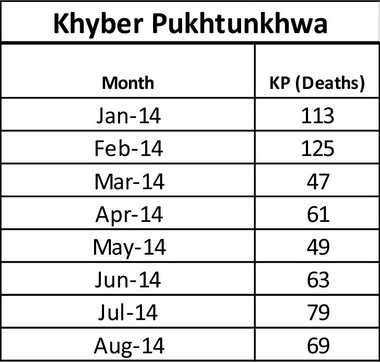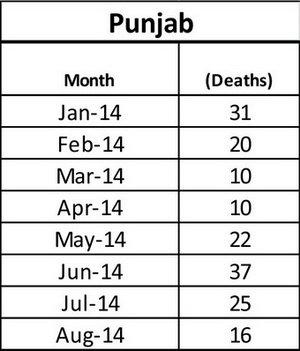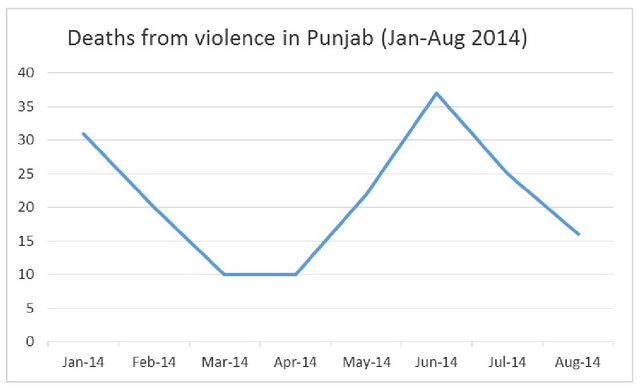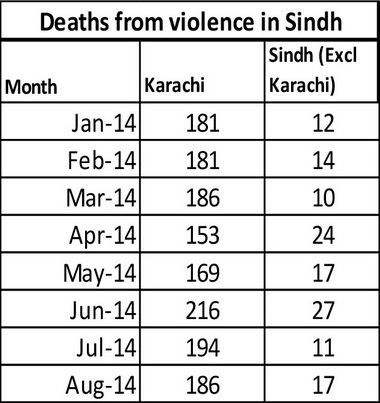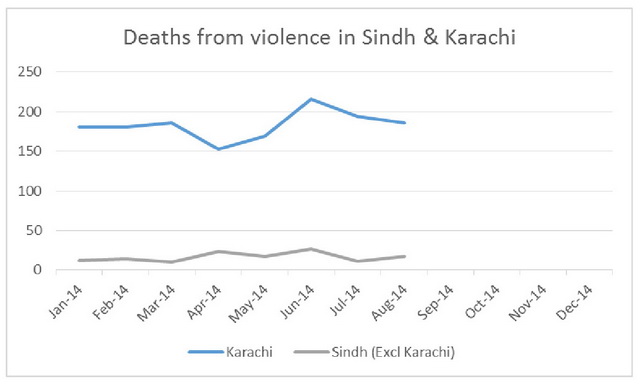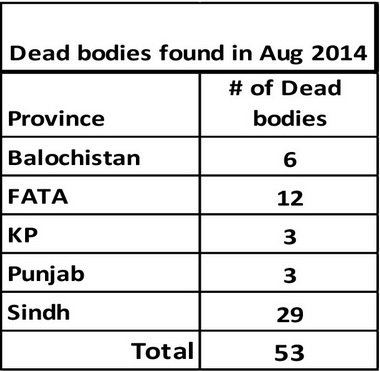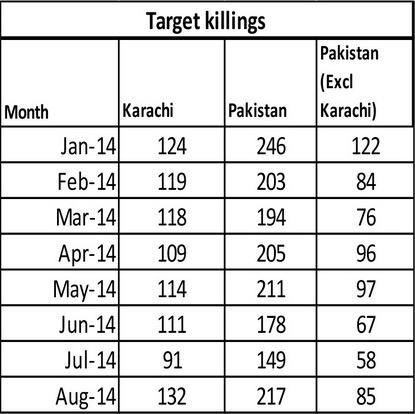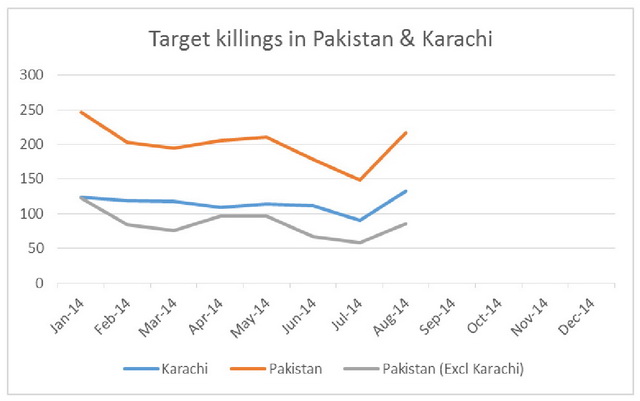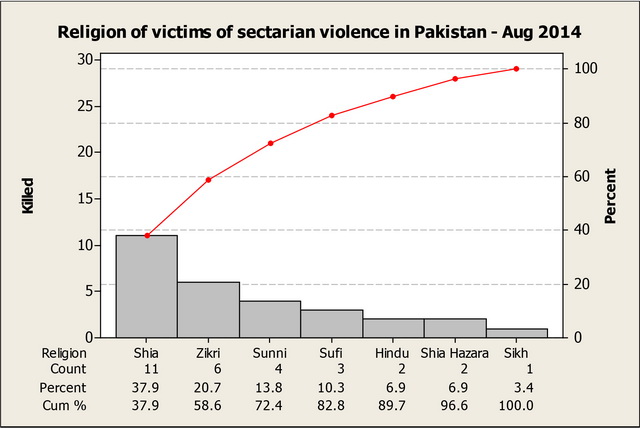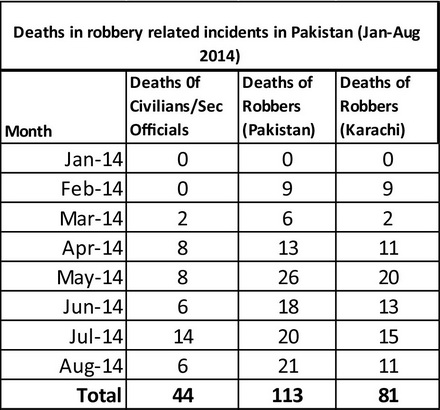This report mainly covers the following topics for the month of August:
Deaths due to violence in the country during August 2014,
Casualties of violence in Balochistan,
Casualties of violence in FATA,
Casualties of violence in Khyber Pukhtunkhwa (KP),
Casualties of violence in Punjab,
Casualties of violence in Sindh,
Sectarian violence in Pakistan.
All these events and other facts reported in the national newspapers are collected to make this report as informative and factual as possible. Errors and omissions, as always a possibility in all statistical works including this one, are expected. However, such mistakes do not grossly affect the basic objective of this report.
CRSS will appreciate receiving comments that the readers may have on this report.
Report prepared by:
Mohammad Nafees
Senior Research Fellow
Center for Research and Security Studies
NOTE: Readers can approach CRSS for source of any information included in the report. Please send your request to: [mail@crss.pk or mohammad.nafees@yahoo.com]
OVERVIEW
Deaths due to violence in the country during August 2014:
Nearly 20% reduction in deaths off violence 549 dead and 201 injured in the month of August 2014 compared to the last month’s figure (Refer table 1 and graph 1). Major cause of this reduction was the slowdown of military operation in the North Waziristan and Khyber Agency.
Table 1: Deaths from violence in Pakistan – Jan-Aug 2014
Graph 1: Deaths from violence in Pakistan – Jan-Aug 2014
The slowdown in military operation resulted in lower number of fatalities in FATA from 348 to 178 this month. The province of Sindh registered the highest number of deaths during August. Surprisingly, the capital of the country, Islamabad, had no report of violence during the month of August though it remained highly affected of political turbulence. The most populous Punjab province also recorded a 25% decline in deaths off violence during this month (Refer graph 2), while Azad Jammu and Kashmir and Gilgit Baltistan enjoyed the second consecutive month of peace as there were no casualties off violence were reported from there during July and August.
Graph 2: Deaths from violence in Pakistan – Jan-Aug 2014
The data on victims off violence for August shows that some 50% of them were militants and criminals, a proof of the affectivity of the ongoing security operations in the country. However, compared to last month, the death rate for the militants came down nearly 30% while the death rates off target killings mainly civilians, politicians (activists and supporters), religious persons, and religious party activists went up significantly. A sharp decline in the death rate of the government officials and security personnel was also observed during this month (Refer table 2).
Table 2: Victims of violence in Pakistan – Jan-Aug 2014
During the month of August Karachi topped the districts for most deaths, followed by North Waziristan, Khyber Agency, Turbat, Quetta, D.I. Khan, Kohat, Dir, and many others (Refer graph 3).
Graph 3: Deaths from violence on city level – Aug 2014
The historical data on violence shows that the incidents of target killings have gone up in the country from 149 to 214 deaths during this month. Likewise, the sectarian killings have also witnessed a rise from 23 to 29 deaths in the month of August. All other forms of violence like militants’ attacks, security operation, terrorism, and drone attacks have shown a declining trend (Refer table 3).
Table 3: Deaths from violence in Pakistan – Jan-Aug 2014 (Historical data)
Casualties of violence in Balochistan
Dead = 83
Injured = 86
The wave of violence struck Balochistan again and raised the graph of fatalities by more than 100% this month (Refer table 4 and graph 4). This sharp rise of death rate in Balochistan in the backdrop of the ongoing military operation in FATA and the claims of Pakistan Army of clearing most of the areas of the North Waziristan from the militants raises a question about the maneuverability of the militant organizations that help them quickly shift their area of operation from one place to another. The twin attacks at PAF Airbases at Samungli and Khalid airbases in Quetta were another daring acts by the different groups of the Tehreek-e-Taliban of Pakistan after their attack on Karachi Airport a couple of months ago that had triggered military operation in the North Waziristan.
Table 4: Deaths in Balochistan – Jan-Aug 2014
Graph 4: Deaths from violence in Balochistan – Aug 2014
According to the data on the victims off violence in Balochistan, the militants had the highest number of fatalities, 40 followed by civilians26, security officials 10, six religious persons , and one political activist. Turbat and Quetta were the two locations that suffered the highest number of human losses during this month followed by other districts of the province (Refer graph 5).
Graph 5: Deaths from violence in Balochistan (Districtwise) – Aug 2014
Casualties of violence in FATA
Dead = 178
Injured = 48
Compared to last month, a sharp decline in death rate was noticed in FATA during this month (Refer table 5 and graph 6). 147 out of 178 dead in FATA were militants that were killed during security operations, encounters, and drone attacks, in the North Waziristan and Khyber Agency while militants’ attacks and bomb explosions took 20 lives. There were no reports of suicide attack, firing of mortar shell, or hand grenade attacks in FATA region during this month. 12 dead bodies were also discovered on different dates at different locations in Khyber Agency of FATA where a rivalry between a militant organization and Peace Committee Lashkar has been going on since last year. Majority of these dead bodies belonged to Lashkar-e-Islami and two of them were soldiers belonging to Frontier Constabulary. The most heinous act of violence that took place in FATA region during this month was the incident of a roadside bomb explosion in Bajaur Agency wherein three women teachers, two children and a driver were killed[1]
Table 5: Deaths in FATA – Jan-Aug 2014
Graph 6: Deaths from violence FATA – Aug 2014
Casualties of violence in Khyber Pakhtunkhwa (KP)
Dead =69
Injured = 33
In Khyber Pakhtunkhwa (KP), a slight respite in death rate was observed during this month at a loss of 66 persons compared to 79 persons’ lost in the previous month (Refer table 6 and graph 7).
Table 6: Deaths in KP – Jan-Aug 2014
Graph 7: Deaths from violence KP – Aug 2014
The highest victims off violence in KP were civilians, almost 50% of the total, followed by 40%militants, and political activists. On district level, D.I.Khan had the highest rate with 15 persons dead followed by 12 in Kohat, 11 in Dir, 10 in Bannu , six in Swat , five in Peshawar . An interesting point to note is an increasing trend of custodial deaths of militants in KP province. Since April this year, at least 28 militants have been reported dead in jail, majority of them were allegedly died because of cardiac arrest (Refer table 7). In the month of August 2014, eight militants had died in Kohat jail and five in Swat. This sudden increase in custodial deaths of militants needs to be investigated to determine the real cause behind such incidents.
Table 7: Custodial deaths in KP – Jan-Aug 2014
The major causes of death in KP were target killings numbering 24, 13 custodial deaths, nine in security operation, six in militants’ attacks, and four in terrorism.
Casualties of violence in Punjab
Dead = 16
Injured = 12
The province of Punjab is relatively peaceful among all other provinces and according to the data on violence shows that the graph of death rate in the Punjab has been sliding downward trend since June 2014 (Refer table 8 and graph 8). Among the victims of violence during the month under review are civilians (7), criminals (7), and one each political activist and security official. Majority of crimes in the Punjab province are related with the robbery. The security forces killed seven robbers in various parts of the province during this month and two private security guards were killed when six robbers carried out a robbery at a bank in Multan.
Table 8: Deaths in Punjab – Jan-Aug 2014
Graph 8: Deaths from violence Punjab – Aug 2014
Casualties of violence in Sindh
Dead = 203
Injured = 21
Karachi:
Dead = 186
Injured = 20
With a slowdown in military operation in FATA, the province of Sindh, has now replaced FATA as the region having lost the highest number of human lives in the country off violence. However, the numbers of persons died in August were slightly less than the figure of last month. Karachi, as usual, was the only district of Sindh where the death rate was more than 90% of the total death rate of Sindh (Refer table 9 and graph 9).
Table 9: Deaths in Sindh – Jan-Aug 2014
Graph 9: Deaths from violence Sindh & Karachi – Aug 2014
Among the victims of violence, civilians were the highest with a tally of 145 followed by 24 security officials, 12 political activists, 10 militants, five religious party workers, and three religious persons. The locations highly affected off violence in Sindh were Lyari where37 incidents are reported followed by 17 in Malir, 15 each in Landhi and Sohrab Goth, 11 in Korangi, nine in Baldia Town, eight in Orangi Town, seven each in Liaquat Abadand Surjani Town. In the month of August, 53 dead bodies were found throughout the country and 29 of them were discovered in Sindh (Refer table 10). 26 out of 29 dead bodies were discovered in Karachi alone.
Table 10: Deaths in Sindh – Jan-Aug 2014
Major causes of fatalities in Sindh were target killings (146) and security operations (52). The methods used for violence were gunning down of the victims, encounters with the security officials, and indiscriminate firings. Despite the ongoing operation in Karachi, the incidents of target killings took a sharp rise not only in Karachi but throughout the country during this month (Refer table 11 and graph 10). Are the militants and criminals changing the tactics of their crimes in the face of ongoing operations in Karachi and NWA? This seems to be a very convincing reason for an upward trend in target killing incidents.
Table 11: Deaths from target killings – Jan-Aug 2014
Graph 10: Deaths from violence Pakistan & Karachi – Aug 2014
Sectarian violence in Pakistan:
29 persons lost their lives in sectarian violence throughout the country this month and the majority of them were from the province of Sindh (20), eight in Balochistan, and one in KP. Karachi, among all other districts of the country, had the highest victims of sectarian violence followed by Awaran, Quetta, Umerkot, Hyderabad, and Peshawar (Refer graph 11).
Graph 11: Deaths from sectarian violence in Pakistan – Aug 2014
As many as 50 percent victims of sectarian violence during August were Shia Muslims. While, Sunni and the followers of Sufism were 25 percent. For the first time, the followers of Zikri sect were also targeted in Balochistan and Hindu and Sikh were not spared either (Refer graph 12). People belonging to all religions as well as all sects of Muslim religion have become unsafe in the country that was created in the name of religion.
Graph 12: Religion of victims of sectarian violence in Pakistan – Aug 2014
Conclusion:
The cumulative death toll for the month of August was less than that of July because possibly of decline in fatalities of militants (30% down) and security personnel (60% down) while similar number the graph for all other victims went up (Refer table 2).
The data for August and previous month suggests that robbery related incidents are on the rise in the country as well. During this year so far, nearly 44 civilians or security officials have been killed by the robbers during their criminal activities in the country. More than 50percent of these victims were from Sindh while the Punjab had 25percent victims. The security measures taken by the law enforcing agencies left 113 robbers dead in the country during last eight months and nearly 80 percent of them were killed in Karachi only (Refer table 12).
Table 12: Deaths in robbery related incidents – Jan-Aug 2014
The latest data suggests that there is no letup in sectarian killings in the country and phenomenon is spreading to various parts of the country. Even the smallest minority of Zikri sect and Sikh community became target of sectarian violence in the country this month leaving seven of them dead for no crime of them except their sectarian or religious differences.
The ongoing operations in Karachi and NWA are bringing some positive results for restoration of peace in the violence ridden areas of the country. Surprisingly, no suicide attack has been reported during the last two months (Refer table 2) pointing perhaps to the effectiveness of military operations in Waziristan and Karachi. Although, security agencies claim that majority of the areas that were once controlled by the militants have now been cleared, the emergence of these militants at other locations in the country continue to pose serious challenge to such claims.
http://www.thenews.com.pk/Todays-News-13-32335-Three-women-teachers-among-six-killed-in-Bajaur↑

